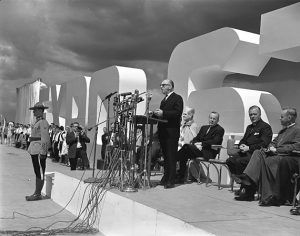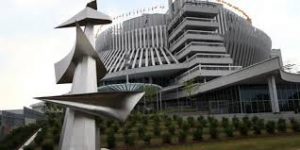
On April 27th 1967, the whole world was watching Jean Drapeau’s inaugurative speech for the universal world fair. The Montreal mayor then said he maintained hope that it was possible to prevent the destruction of buildings and elements of the Expo’s site, so that the world fair should thus forever be imprinted in people’s memories on American soil. Drapeau’s dream of perenniality for the world fair has not quite come true.
Indeed, 50 years after the world fair that attracted 50 million people happened, few buildings or elements of Expo 67 subsist on Parc Jean-Drapeau. Out of 98 pavilions, only six subsist on the site to this day: the French, Québec, American, Tunisian, Jamaican and Korean pavilions. They are now respectively the Casino and its annex, the Biosphere, an office, a reception house and a bus stop.
Jean Drapeau’s grandson, Antoine Drapeau, says he thinks the city has done an okay job in preserving the site, but could have done more to preserve the glorious legacy of Expo ’67.
Julie Bélanger organizes extremely popular and free educational tours of the park to honour the legacy of the event. She is part of a handful of activists who really push the city and the Parc Jean-Drapeau Society to revitalize the site. She says that most of the big celebrations to come for the 50th anniversary of the Expo remain to be announced.
Bélanger says there are sadly many artefacts that aren’t preserved the way they should. For example: both sculptures Orbite Optique No 2 by Gerald Gladstone and Obélisque Oblique by Henri-Georges Adam do not have commemorative plaques that tells when they were made, who made them and why they are on the former Expo 67 site. Gladstone’s statue stands in front of the Six Flags amusement park and Adam’s in front of the casino. Bélanger also deplores the fact that the Korea tower is now lying on its side, rotting behind the Gilles-Villeneuve F1 tracks since 2011.

50 years later, those remains show a forgotten albeit glorious past. In his book “Montreal’s Expo 67”, Bill Cotter writes that Expo 67 hosted the largest art display of any world’s fair.
Historian Roger La Roche was thirteen years old when he started working at Expo 67. He has kept researching and working on the preservation of the site to this day. La Roche says he regrets that the city, the government of Québec, the government of Canada and the Parc Jean-Drapeau Society don’t do more to revive the site. He says the old pavilions lose their meaning if we cannot find a similar ambiance to that of the Expo at the park.
La Roche says that the only two things that really bring Montrealers on the islands are the Grand Prix and Evenko concerts in the summer– both events are private and do not give back to the Expo 67 legacy.
Of all people who attend the Grand Prix Formula 1 and Osheaga on Sainte-Hélène and Notre-Dame islands, how many of them know about the world class exhibition?
Antoine Drapeau says not that many. “The average citizen forgets that all of this site did not exist before the Expo.” He says people forget that a 100 years ago, all of this was only water and the site was built with man power, with soil dug from the entrails of Montreal.
The Parc Jean-Drapeau Society says its actions are constantly influenced by the spirit and the legacy of Expo ’67. The Society states that it has plans to build a site where one of the principal objectives is to recreate the spirit of Expo ’67. But that remains to be seen.
On the anniversary year of Expo 67, what is certain is that the universal fair is not being remembered the way mayor Drapeau envisioned it in his 1967 inaugural speech.
